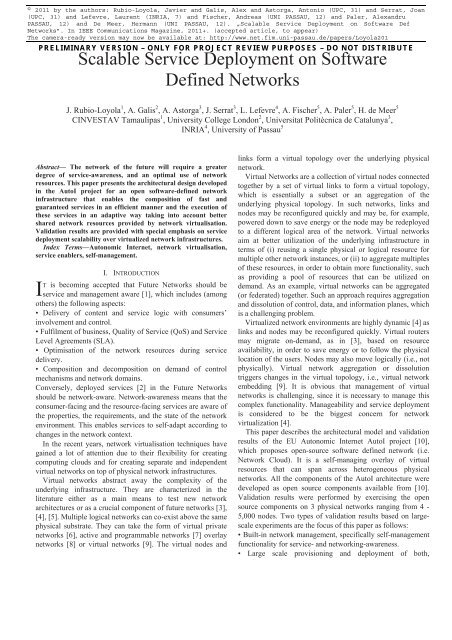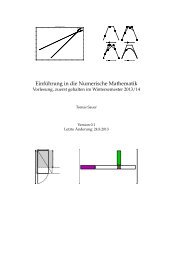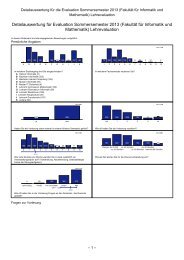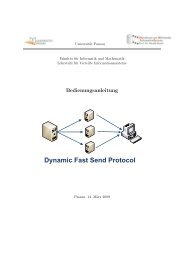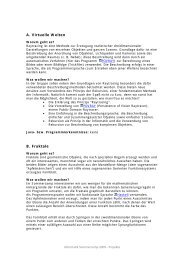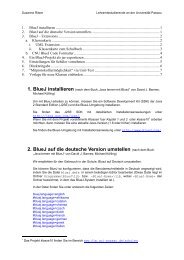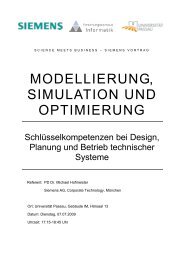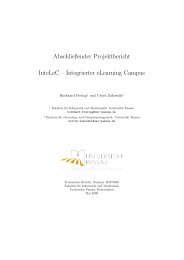Scalable Service Deployment on Software Defined Networks
Scalable Service Deployment on Software Defined Networks
Scalable Service Deployment on Software Defined Networks
You also want an ePaper? Increase the reach of your titles
YUMPU automatically turns print PDFs into web optimized ePapers that Google loves.
© 2011 by the authors: Rubio-Loyola, Javier and Galis, Alex and Astorga, Ant<strong>on</strong>io (UPC, 31) and Serrat, Joan<br />
(UPC, 31) and Lefevre, Laurent (INRIA, 7) and Fischer, Andreas (UNI PASSAU, 12) and Paler, Alexandru (UNI<br />
PASSAU, 12) and De Meer, Hermann (UNI PASSAU, 12). „<str<strong>on</strong>g>Scalable</str<strong>on</strong>g> <str<strong>on</strong>g>Service</str<strong>on</strong>g> <str<strong>on</strong>g>Deployment</str<strong>on</strong>g> <strong>on</strong> <strong>Software</strong> <strong>Defined</strong><br />
<strong>Networks</strong>”. In IEEE Communicati<strong>on</strong>s Magazine, 2011+. (accepted article, to appear)<br />
The camera-ready versi<strong>on</strong> may now be available at: http://www.net.fim.uni-passau.de/papers/Loyola201<br />
PRELIMINARY VERSION – ONLY FOR PROJECT REVIEW PURPOSES – DO NOT DISTRIBUTE<br />
Abstract The network of the future will require a greater<br />
degree of service-awareness, and an optimal use of network<br />
resources. This paper presents the architectural design developed<br />
in the AutoI project for an open software-defined network<br />
infrastructure that enables the compositi<strong>on</strong> of fast and<br />
guaranteed services in an efficient manner and the executi<strong>on</strong> of<br />
these services in an adaptive way taking into account better<br />
shared network resources provided by network virtualisati<strong>on</strong>.<br />
Validati<strong>on</strong> results are provided with special emphasis <strong>on</strong> service<br />
deployment scalability over virtualized network infrastructures.<br />
Index TermsAut<strong>on</strong>omic Internet, network virtualisati<strong>on</strong>,<br />
service enablers, self-management.<br />
I<br />
<str<strong>on</strong>g>Scalable</str<strong>on</strong>g> <str<strong>on</strong>g>Service</str<strong>on</strong>g> <str<strong>on</strong>g>Deployment</str<strong>on</strong>g> <strong>on</strong> <strong>Software</strong><br />
<strong>Defined</strong> <strong>Networks</strong><br />
J. Rubio-Loyola 1 , A. Galis 2 , A. Astorga 3 , J. Serrat 3 , L. Lefevre 4 , A. Fischer 5 , A. Paler 5 , H. de Meer 5<br />
CINVESTAV Tamaulipas 1 , University College L<strong>on</strong>d<strong>on</strong> 2 , Universitat Politècnica de Catalunya 3 ,<br />
INRIA 4 , University of Passau 5<br />
I. INTRODUCTION<br />
T is becoming accepted that Future <strong>Networks</strong> should be<br />
service and management aware [1], which includes (am<strong>on</strong>g<br />
others) the following aspects:<br />
<br />
involvement and c<strong>on</strong>trol.<br />
Fulfilment of business, Quality of <str<strong>on</strong>g>Service</str<strong>on</strong>g> (QoS) and <str<strong>on</strong>g>Service</str<strong>on</strong>g><br />
Level Agreements (SLA).<br />
<br />
delivery.<br />
<br />
mechanisms and network domains.<br />
C<strong>on</strong>versely, deployed services [2] in the Future <strong>Networks</strong><br />
should be network-aware. Network-awareness means that the<br />
c<strong>on</strong>sumer-facing and the resource-facing services are aware of<br />
the properties, the requirements, and the state of the network<br />
envir<strong>on</strong>ment. This enables services to self-adapt according to<br />
changes in the network c<strong>on</strong>text.<br />
In the recent years, network virtualisati<strong>on</strong> techniques have<br />
gained a lot of attenti<strong>on</strong> due to their flexibility for creating<br />
computing clouds and for creating separate and independent<br />
virtual networks <strong>on</strong> top of physical network infrastructures.<br />
Virtual networks abstract away the complexity of the<br />
underlying infrastructure. They are characterized in the<br />
literature either as a main means to test new network<br />
architectures or as a crucial comp<strong>on</strong>ent of future networks [3],<br />
[4], [5]. Multiple logical networks can co-exist above the same<br />
physical substrate. They can take the form of virtual private<br />
networks [6], active and programmable networks [7] overlay<br />
networks [8] or virtual networks [9]. The virtual nodes and<br />
links form a virtual topology over the underlying physical<br />
network.<br />
Virtual <strong>Networks</strong> are a collecti<strong>on</strong> of virtual nodes c<strong>on</strong>nected<br />
together by a set of virtual links to form a virtual topology,<br />
which is essentially a subset or an aggregati<strong>on</strong> of the<br />
underlying physical topology. In such networks, links and<br />
nodes may be rec<strong>on</strong>figured quickly and may be, for example,<br />
powered down to save energy or the node may be redeployed<br />
to a different logical area of the network. Virtual networks<br />
aim at better utilizati<strong>on</strong> of the underlying infrastructure in<br />
terms of (i) reusing a single physical or logical resource for<br />
multiple other network instances, or (ii) to aggregate multiples<br />
of these resources, in order to obtain more functi<strong>on</strong>ality, such<br />
as providing a pool of resources that can be utilized <strong>on</strong><br />
demand. As an example, virtual networks can be aggregated<br />
(or federated) together. Such an approach requires aggregati<strong>on</strong><br />
and dissoluti<strong>on</strong> of c<strong>on</strong>trol, data, and informati<strong>on</strong> planes, which<br />
is a challenging problem.<br />
Virtualized network envir<strong>on</strong>ments are highly dynamic [4] as<br />
links and nodes may be rec<strong>on</strong>figured quickly. Virtual routers<br />
may migrate <strong>on</strong>-demand, as in [3], based <strong>on</strong> resource<br />
availability, in order to save energy or to follow the physical<br />
locati<strong>on</strong> of the users. Nodes may also move logically (i.e., not<br />
physically). Virtual network aggregati<strong>on</strong> or dissoluti<strong>on</strong><br />
triggers changes in the virtual topology, i.e., virtual network<br />
embedding [9]. It is obvious that management of virtual<br />
networks is challenging, since it is necessary to manage this<br />
complex functi<strong>on</strong>ality. Manageability and service deployment<br />
is c<strong>on</strong>sidered to be the biggest c<strong>on</strong>cern for network<br />
virtualizati<strong>on</strong> [4].<br />
This paper describes the architectural model and validati<strong>on</strong><br />
results of the EU Aut<strong>on</strong>omic Internet AutoI project [10],<br />
which proposes open-source software defined network (i.e.<br />
Network Cloud). It is a self-managing overlay of virtual<br />
resources that can span across heterogeneous physical<br />
networks. All the comp<strong>on</strong>ents of the AutoI architecture were<br />
developed as open source comp<strong>on</strong>ents available from [10].<br />
Validati<strong>on</strong> results were performed by exercising the open<br />
source comp<strong>on</strong>ents <strong>on</strong> 3 physical networks ranging from 4 -<br />
5,000 nodes. Two types of validati<strong>on</strong> results based <strong>on</strong> largescale<br />
experiments are the focus of this paper as follows:<br />
Built-in network management, specifically self-management<br />
functi<strong>on</strong>ality for service- and networking-awareness.<br />
Large scale provisi<strong>on</strong>ing and deployment of both,<br />
1
applicati<strong>on</strong> services and management services over virtual<br />
infrastructures.<br />
This paper is structured as follows. Secti<strong>on</strong> II presents the<br />
AutoI architectural framework and its relevant systems.<br />
Secti<strong>on</strong> III presents validati<strong>on</strong> results. Secti<strong>on</strong> IV provides<br />
some technical discussi<strong>on</strong>. Secti<strong>on</strong> V describes related work.<br />
Secti<strong>on</strong> VI c<strong>on</strong>cludes the paper.<br />
II. AUTOI ARCHITECTURAL FRAMEWORK AND SYSTEMS<br />
The AutoI framework c<strong>on</strong>sists of a software defined<br />
network described with the help of five abstracti<strong>on</strong>s the<br />
OSKMV planes: Orchestrati<strong>on</strong> Plane (OP). <str<strong>on</strong>g>Service</str<strong>on</strong>g> Enablers<br />
Plane (SP), Knowledge Plane (KP), Management Plane (MP)<br />
and Virtualisati<strong>on</strong> Plane (VP). At the physical level, they are<br />
embedded <strong>on</strong> network hosts, devices, and servers within the<br />
network. The main purpose of the OSKMV planes is to make<br />
the Future <strong>Networks</strong> capable of self-knowledge, and<br />
ultimately fully self-managing. The AutoI architectural model<br />
is shown in Figure 1 and a descripti<strong>on</strong> of the major elements<br />
follows. Open source platform comp<strong>on</strong>ents developed in<br />
support of the AutoI architecture, which are available from<br />
[10], are indicated as (*) in the following secti<strong>on</strong>.<br />
A. Orchestrati<strong>on</strong> Plane Overview<br />
The purpose of the Orchestrati<strong>on</strong> Plane is to govern the<br />
behaviour of the system in resp<strong>on</strong>se to changing c<strong>on</strong>text and<br />
in accordance with applicable business goals and policies. It<br />
supervises and integrates all other plan<br />
integrity of the future Internet management operati<strong>on</strong>s.<br />
The Orchestrati<strong>on</strong> Plane is a c<strong>on</strong>trol framework into which<br />
any number of comp<strong>on</strong>ents can be plugged into in order to<br />
<str<strong>on</strong>g>Service</str<strong>on</strong>g> Enablers Plane<br />
<str<strong>on</strong>g>Service</str<strong>on</strong>g><br />
Lifecycle<br />
Management<br />
vSPI<br />
Comp<strong>on</strong>ent<br />
Physical Resource<br />
Business Goals<br />
Customer Needs<br />
Models and<br />
Ontologies<br />
<br />
User Interface <str<strong>on</strong>g>Service</str<strong>on</strong>g>s<br />
Lifecycle Management <str<strong>on</strong>g>Service</str<strong>on</strong>g>s<br />
Mapping<br />
Aut<strong>on</strong>omic Management System<br />
Management Plane<br />
Knowledge Plane<br />
vCPI vCPI vCPI<br />
Developer Interface<br />
Operator Interface<br />
Distributi<strong>on</strong><br />
Federati<strong>on</strong><br />
Negotiati<strong>on</strong><br />
Intra-System View<br />
Distributed<br />
Orchestrati<strong>on</strong><br />
Comp<strong>on</strong>ent<br />
<br />
Others<br />
Distributi<strong>on</strong><br />
Federati<strong>on</strong><br />
System View<br />
Semantic Bus<br />
vCPI vCPI<br />
Fig. 1. AUTOI Architectural Model- software defined network<br />
achieve the required functi<strong>on</strong>ality. These comp<strong>on</strong>ents could<br />
have direct interworking with c<strong>on</strong>trol algorithms, situated in<br />
the c<strong>on</strong>trol plane of the Internet (i.e. to provide real time<br />
reacti<strong>on</strong>), and interworking with other management functi<strong>on</strong>s<br />
(i.e. to provide near real time reacti<strong>on</strong>).<br />
In practical terms, the Orchestrati<strong>on</strong> Plane c<strong>on</strong>trols <strong>on</strong>e or<br />
more Aut<strong>on</strong>omic Management Systems (AMS described<br />
later). It acts as c<strong>on</strong>trol workflow for AMSs ensuring their<br />
bootstrapping, initialisati<strong>on</strong>, dynamic rec<strong>on</strong>figurati<strong>on</strong>,<br />
adaptati<strong>on</strong> and c<strong>on</strong>textualisati<strong>on</strong>, optimisati<strong>on</strong>, organisati<strong>on</strong>,<br />
closing down. It is functi<strong>on</strong>ally integrated by <strong>on</strong>e or more<br />
Distributed Orchestrati<strong>on</strong> Comp<strong>on</strong>ents (DOC) and a dynamic<br />
knowledge base c<strong>on</strong>sisting of a set of models and <strong>on</strong>tologies<br />
and appropriate mapping logic and buses. DOCs can federate<br />
via buses. The internal design details of the Orchestrati<strong>on</strong><br />
Plane can be found in [11].<br />
B. Aut<strong>on</strong>omic Management System (AMS)<br />
A key advantage of the AutoI architecture is that it can<br />
provide a programmable mix of isolati<strong>on</strong> and sharing of<br />
network resources. A key advantage of separating the c<strong>on</strong>trol<br />
and data planes is to provide increased isolati<strong>on</strong> for an<br />
applicati<strong>on</strong> or set of applicati<strong>on</strong>s.<br />
Each Aut<strong>on</strong>omic Management System (AMS) is part of the<br />
Management Plane (described later) and it includes interfaces<br />
to a dedicated set of models and <strong>on</strong>tologies and interfaces to<br />
<strong>on</strong>e or more Distributed Orchestrati<strong>on</strong> Comp<strong>on</strong>ents. Mapping<br />
logic enables the data stored in models to be transformed into<br />
knowledge and combined with knowledge stored in <strong>on</strong>tologies<br />
to provide a c<strong>on</strong>text-sensitive assessment of the operati<strong>on</strong> of<br />
<strong>on</strong>e or more virtual resources.<br />
Inter-System View<br />
Another set of interfaces<br />
enables framework services,<br />
<br />
such as directory services,<br />
naming, federati<strong>on</strong>, and<br />
System View<br />
others, to be used by the<br />
AMS.<br />
Negotiati<strong>on</strong><br />
Others<br />
Federati<strong>on</strong> <str<strong>on</strong>g>Service</str<strong>on</strong>g>s<br />
Mapping<br />
Aut<strong>on</strong>omic Management System<br />
Management Plane<br />
Knowledge Plane<br />
Distributi<strong>on</strong><br />
Federati<strong>on</strong><br />
Negotiati<strong>on</strong><br />
Orchestrati<strong>on</strong><br />
Plane<br />
End-User<br />
Virtualised<br />
<str<strong>on</strong>g>Service</str<strong>on</strong>g>s<br />
End-User Composite<br />
Virtualised <str<strong>on</strong>g>Service</str<strong>on</strong>g>s<br />
Virtualisati<strong>on</strong><br />
Plane<br />
Others<br />
2<br />
C. Distributed Orchestrati<strong>on</strong><br />
Comp<strong>on</strong>ent (DOC)<br />
The Distributed<br />
Orchestrati<strong>on</strong> Comp<strong>on</strong>ent<br />
(DOC) (*) provides a set of<br />
framework network services.<br />
Framework services provide<br />
a comm<strong>on</strong> infrastructure that<br />
enables all AMSs c<strong>on</strong>trolled<br />
by the Orchestrati<strong>on</strong> Plane to<br />
have (un)plug-and-play<br />
behaviour. Applicati<strong>on</strong>s<br />
compliant with these<br />
framework services share<br />
comm<strong>on</strong> security, metadata,<br />
administrati<strong>on</strong>, and<br />
management services. The
DOC enables the following framework network services to the<br />
AMSs under its c<strong>on</strong>trol:<br />
Federati<strong>on</strong>: each AMS is resp<strong>on</strong>sible for its own set of<br />
virtual and n<strong>on</strong>-virtual resources and management services<br />
that it governs. Federati<strong>on</strong> enables a set of domains to be<br />
combined into a larger domain, where selected functi<strong>on</strong>ality of<br />
each c<strong>on</strong>stituent domain c<strong>on</strong>tributes to the overall<br />
functi<strong>on</strong>ality of the larger domain.<br />
Negotiati<strong>on</strong>: each AMS advertises a set of capabilities (i.e.,<br />
services and/or resources) that it offers for use by other<br />
comp<strong>on</strong>ents in the Orchestrati<strong>on</strong> Plane.<br />
Distributi<strong>on</strong>: this service enables tasks to be split into parts<br />
that run c<strong>on</strong>currently <strong>on</strong> multiple AMS c<strong>on</strong>trolled by a DOC,<br />
or even across multiple DOCs. This functi<strong>on</strong> ensures that<br />
AMSs with different implementati<strong>on</strong>s and functi<strong>on</strong>ality can<br />
collaborate.<br />
Governance: this service enables each AMS to be able to<br />
operate in an individual, distributed, or collaborative mode.<br />
Business goals, service requirements, c<strong>on</strong>text, capabilities and<br />
c<strong>on</strong>straints are all c<strong>on</strong>sidered as part of the decisi<strong>on</strong> making<br />
process.<br />
Intra-System View: this service provides an overall,<br />
composite view of the system as seen by the comp<strong>on</strong>ents<br />
within a DOC.<br />
Inter-System View: this service provides an overall,<br />
composite view of collaborating DOCs, as in a multiple<br />
domain system.<br />
D. <str<strong>on</strong>g>Service</str<strong>on</strong>g> Enablers Plane Overview<br />
The <str<strong>on</strong>g>Service</str<strong>on</strong>g> Enablers Plane (SP) c<strong>on</strong>sists of functi<strong>on</strong>s for<br />
the automatic (re)deployment of new management services,<br />
protocols as well as resource-facing and end-user facing<br />
services. It includes enablers to allow code to be executed <strong>on</strong><br />
the network entities. This functi<strong>on</strong>ality is implemented by the<br />
ANPI (Aut<strong>on</strong>omic Network Programming Interface) (*)[10],<br />
which supports large scale network programmability in<br />
deployed virtual networks. The safe and c<strong>on</strong>trolled<br />
deployment of new code enables new services to be activated<br />
<strong>on</strong> demand, and to be made available to both, management<br />
and orchestrati<strong>on</strong> planes for the benefit of service-awareness.<br />
This approach has the following advantages:<br />
Automatic service deployment allowing a significant<br />
number of new services to be offered <strong>on</strong> demand.<br />
Flexible network c<strong>on</strong>figurati<strong>on</strong> capabilities.<br />
Special management functi<strong>on</strong>s and services can be easily<br />
enabled locally for testing purposes before they are<br />
automatically deployed network-wide.<br />
Flexible support for service migrati<strong>on</strong>, both for c<strong>on</strong>sumerfacing<br />
and the resource-facing services.<br />
E. Knowledge Plane Overview<br />
The Knowledge Plane was proposed by Clark et al. [13] as<br />
a new dimensi<strong>on</strong> to a network architecture, c<strong>on</strong>trasting with<br />
the data and c<strong>on</strong>trol planes; its purpose is to provide<br />
knowledge and expertise to enable the network to be selfm<strong>on</strong>itoring,<br />
self-analysing, self-diagnosing and self-<br />
maintaining.<br />
AutoI introduces a narrow functi<strong>on</strong>ality Knowledge Plane<br />
(KP), c<strong>on</strong>sisting of models and <strong>on</strong>tologies, to provide<br />
increased a <br />
brings together widely distributed data collecti<strong>on</strong>, wide<br />
availability of that data, and sophisticated and adaptive<br />
processing or KP functi<strong>on</strong>s, within a unifying structure. This<br />
brings order and meets the policy, scaling and functi<strong>on</strong>al<br />
requirements of a global network. The main KP comp<strong>on</strong>ents<br />
are a C<strong>on</strong>text and <str<strong>on</strong>g>Service</str<strong>on</strong>g> Informati<strong>on</strong> Platform (CISP) (*)<br />
[10] and <strong>on</strong>tologies, which enable the analysis and inferencing<br />
capabilities. The CISP provides:<br />
informati<strong>on</strong> life cycle management (storage, aggregati<strong>on</strong>,<br />
transformati<strong>on</strong>s, updates, distributi<strong>on</strong>) of all informati<strong>on</strong> and<br />
c<strong>on</strong>text in the network addressing the size/scope.<br />
resp<strong>on</strong>siveness to requests made by the AMS;<br />
triggers for the purpose of c<strong>on</strong>textualisati<strong>on</strong> of AMS<br />
(supported by the c<strong>on</strong>text model of the informati<strong>on</strong> model);<br />
support for robustness enabling the KP to c<strong>on</strong>tinue to<br />
functi<strong>on</strong> as best possible, even under incorrect or incomplete<br />
behaviour of the network itself;<br />
support of virtual networks and virtual system resources in<br />
their needs for privacy and other forms of local c<strong>on</strong>trol, while<br />
enabling them to cooperate for mutual benefit in more<br />
effective network management.<br />
Aut<strong>on</strong>omic Subsystem<br />
C<strong>on</strong>trol 1<br />
Aut<strong>on</strong>omic Subsystem<br />
C<strong>on</strong>trol P<br />
C<strong>on</strong>trol 1 Aut<strong>on</strong>omic Subsystem<br />
C<strong>on</strong>trol P<br />
C<strong>on</strong>trol 1 Input 1<br />
C<strong>on</strong>trol PLife-cycle<br />
Output 1<br />
Input 1<br />
Life-cycle Self-Knowledge Output 1<br />
Input 1<br />
Goals Life-cycle Knowledge Output 1<br />
Goals Self-Knowledge<br />
Input N<br />
Logic Output N<br />
Input N<br />
Logic Output N<br />
Logic Local C<strong>on</strong>text<br />
Input N<br />
Output N<br />
Local C<strong>on</strong>text<br />
Local C<strong>on</strong>text<br />
Sensor 1 Sensor M<br />
Sensor 1 Sensor M<br />
Sensor 1 Enviroment Global C<strong>on</strong>text<br />
Sensor M<br />
Enviroment Global C<strong>on</strong>text<br />
Enviroment Global C<strong>on</strong>text<br />
Fig. 2. Aut<strong>on</strong>omic C<strong>on</strong>trol Loops<br />
Collect Analyse<br />
Change<br />
Decide<br />
Enforce<br />
F. Management Plane Overview<br />
The Management Plane (MP) governs all virtual resources,<br />
performing decisi<strong>on</strong>s <strong>on</strong> their optimal placement, functi<strong>on</strong> and<br />
c<strong>on</strong>tinuous migrati<strong>on</strong>. The functi<strong>on</strong>ality of the MP is<br />
implemented by the AMS (*). The MP functi<strong>on</strong>ality is subject<br />
to c<strong>on</strong>straints determined by the Orchestrati<strong>on</strong> Plane. The MP<br />
is designed to meet the following objectives and functi<strong>on</strong>ality:<br />
Embedded (Inside) Network functi<strong>on</strong>s: The majority of<br />
management functi<strong>on</strong>ality is embedded in the network and it<br />
is abstracted from the human activities. The AMSs run <strong>on</strong><br />
executi<strong>on</strong> envir<strong>on</strong>ments <strong>on</strong> top of virtual networks and<br />
systems, which run <strong>on</strong> top of all current network (i.e. fixed,<br />
wireless and mobile networks) and service physical<br />
infrastructures.<br />
Aware and Self-aware functi<strong>on</strong>s: it m<strong>on</strong>itors the network<br />
and operati<strong>on</strong>al c<strong>on</strong>text as well as internal operati<strong>on</strong>al network<br />
state in order to assess if the network current behaviour serve<br />
3
its purposes.<br />
Adaptive and Self-adaptive functi<strong>on</strong>s: It triggers changes in<br />
network operati<strong>on</strong> (state, c<strong>on</strong>figurati<strong>on</strong>s, etc.) as a result of<br />
changes in network and service c<strong>on</strong>text.<br />
Automatic self-functi<strong>on</strong>s: It enables self-c<strong>on</strong>trol (i.e. self-<br />
FCAPS, self-*) of its internal network operati<strong>on</strong>s, functi<strong>on</strong>s<br />
and state. Manual/external input is provided in the setting-up<br />
of the business goals and other unavoidable functi<strong>on</strong>s.<br />
Extensibility functi<strong>on</strong>s: It adds new functi<strong>on</strong>s without<br />
disturbing the rest of the system (Plug and Play dynamic<br />
programmability of management functi<strong>on</strong>s and services). The<br />
AMSs that implement the functi<strong>on</strong>ality of the MP and the KP<br />
are designed to follow the aut<strong>on</strong>omic c<strong>on</strong>trol loops (collect,<br />
analyse, decide, enforce, change [14]) depicted in Figure 2.<br />
G. Virtualisati<strong>on</strong> Plane Overview<br />
One of the key requirements that differentiate AutoI from<br />
other systems is its emphasis <strong>on</strong> virtualisati<strong>on</strong> of resources and<br />
services. AutoI uses platform virtualisati<strong>on</strong> to provide virtual<br />
services and resources. Platform virtualisati<strong>on</strong> separates an<br />
operating system from its underlying platform resources;<br />
resource virtualisati<strong>on</strong> abstracts physical resources into<br />
manageable units of functi<strong>on</strong>ality. For example, a single<br />
physical resource can appear as multiple virtual resources<br />
(e.g., the c<strong>on</strong>cept of a virtual router, where a single physical<br />
router can support multiple independent routing processes by<br />
assigning different internal resources to each routing process);<br />
alternatively, multiple physical resources can appear as a<br />
single physical resource (e.g., when multiple switches are<br />
t the<br />
set of stacked switches appears as a single virtual switch).<br />
AutoI extends c<strong>on</strong>temporary virtualisati<strong>on</strong> approaches and<br />
aims at building an infrastructure in which virtual machines<br />
can be dynamically relocated to any physical node or server<br />
regardless of locati<strong>on</strong>, network and storage c<strong>on</strong>figurati<strong>on</strong>s and<br />
administrative domain.<br />
The Virtualisati<strong>on</strong> Plane (VP) c<strong>on</strong>sists of software<br />
mechanisms to treat selected physical resources as a<br />
programmable pool of virtual resources that can be organised<br />
by the Orchestrati<strong>on</strong> and Management Planes into appropriate<br />
sets of virtual resources to form comp<strong>on</strong>ents (e.g., increased<br />
storage or memory), devices (e.g., a switch with more ports),<br />
or even networks. The organisati<strong>on</strong> is d<strong>on</strong>e in order to realise<br />
a certain business goal or service requirement. Two special<br />
interfaces, called the vSPI and the vCPI (Virtualisati<strong>on</strong><br />
System Programming Interface) and Virtualisati<strong>on</strong><br />
Comp<strong>on</strong>ent Programming Interface, respectively assess the<br />
basic functi<strong>on</strong>ality of the Virtualisati<strong>on</strong> Plane, for which a<br />
brief descripti<strong>on</strong> is given hereafter.<br />
H. vSPI (Virtualisati<strong>on</strong> System Programmability Interface)<br />
- <br />
resources that a particular Orchestrati<strong>on</strong> Plane governs, and is<br />
resp<strong>on</strong>sible for orchestrating groups of virtual resources in<br />
resp<strong>on</strong>se to changing user needs, business requirements, and<br />
envir<strong>on</strong>mental c<strong>on</strong>diti<strong>on</strong>s. The low-level c<strong>on</strong>figurati<strong>on</strong> (i.e.,<br />
- <br />
vCPI, as explained in the next secti<strong>on</strong>.<br />
The vSPI (*) is resp<strong>on</strong>sible for determining what porti<strong>on</strong> of<br />
a comp<strong>on</strong>ent (i.e., set of virtual resources) is allocated to a<br />
given task. This means that all or part of a virtual resource can<br />
be used for each task, providing an optimised partiti<strong>on</strong>ing of<br />
virtual resources according to business need, priority and<br />
other requirements. Composite virtual services can thus be<br />
c<strong>on</strong>structed using all or part of the virtual resources provided<br />
by each physical resource.<br />
- <br />
resources that it governs. This is different from the vCPI,<br />
- <br />
that it c<strong>on</strong>figures. For example, the vSPI collects global<br />
informati<strong>on</strong> about available physical resources. When an<br />
AMS receives requests to instantiate a new virtual resource it<br />
c<strong>on</strong>tacts the vSPI to determine which physical resources can<br />
be used. The vSPI then instructs the vCPI to instantiate the<br />
virtual resources <strong>on</strong> the correct physical resource for such<br />
purpose. The vSPI informs the AMS when the virtual resource<br />
is ready for use, and the vCPI informs the AMS when each<br />
virtual resource has been successfully rec<strong>on</strong>figured.<br />
I. vCPI (Virtualisati<strong>on</strong> Comp<strong>on</strong>ent Programming Interface)<br />
The vCPI (virtual Comp<strong>on</strong>ent Virtual Interface) (*) is a<br />
modular, scalable and communicati<strong>on</strong> protocol-agnostic,<br />
system for m<strong>on</strong>itoring and managing virtual resources. It<br />
operates locally; for each comp<strong>on</strong>ent of a physical network<br />
there is an embedded vCPI that is operating with third-party<br />
software by using a request/resp<strong>on</strong>se mechanism. It is used for<br />
c<strong>on</strong>structing, modifying and managing virtual networks (VN)<br />
c<strong>on</strong>sisting of virtual links (VL), virtual routers (VR) and<br />
routing services (RS). This enables the Aut<strong>on</strong>omic<br />
Management System (AMS) to manage the physical resource,<br />
and to request virtual resources to be c<strong>on</strong>structed from that<br />
physical resource via the vCPI. The AMS sends deviceindependent<br />
commands to the vCPI, which are translated into<br />
device- and vendor-specific commands that rec<strong>on</strong>figure the<br />
physical resource and manage the virtual resources provided<br />
by that physical resource. The vCPI also provides m<strong>on</strong>itoring<br />
informati<strong>on</strong> from the virtual resources back to the AMS that<br />
c<strong>on</strong>trols that physical resource. Note that the AMS is<br />
resp<strong>on</strong>sible for obtaining management data describing the<br />
physical resource.<br />
The vCPI is resp<strong>on</strong>sible for providing dynamic<br />
management data to its governing AMS that states how many<br />
virtual resources are currently instantiated, and how many<br />
additi<strong>on</strong>al virtual resources of what type can be supported.<br />
The vCPI needs to be aware of the structural informati<strong>on</strong> of<br />
the relati<strong>on</strong>s am<strong>on</strong>g virtual resources, and therefore, a<br />
discovery mechanism is included to inspect the c<strong>on</strong>tents of a<br />
physical comp<strong>on</strong>ent and map it to a data structure.<br />
More details of the AutoI open source software defined<br />
network comp<strong>on</strong>ents that integrate the five-plane AUTOI<br />
approach introduced earlier are provided in [10] [12].<br />
4
III. PRACTICAL APPROACH AND VALIDATION RESULTS<br />
This secti<strong>on</strong> tests the AutoI framework and the open source<br />
comp<strong>on</strong>ents, which were installed and run <strong>on</strong> 3 physical<br />
testbed networks ranging from 4 to 5,000 nodes. It provides<br />
relevant results emphasising in the creati<strong>on</strong> of virtual<br />
networks, service deployment and scalability aspects. The<br />
secti<strong>on</strong> c<strong>on</strong>centrates <strong>on</strong> wired physical networks. The<br />
interested reader will find a descripti<strong>on</strong> of the AutoI support<br />
for mobile users in [10].<br />
A. Creati<strong>on</strong> of Virtual <strong>Networks</strong><br />
In AutoI, virtual networks can be set up by means of<br />
administrative decisi<strong>on</strong>s, programmed at a given time,<br />
triggered by events like threshold crossings, or they can be<br />
created <strong>on</strong> demand.<br />
This secti<strong>on</strong> dem<strong>on</strong>strates the AutoI c<strong>on</strong>text-aware, <strong>on</strong>demand,<br />
scalable creati<strong>on</strong> of functi<strong>on</strong>al virtual networks. The<br />
term functi<strong>on</strong>al implies that virtual networks are ready to<br />
support applicati<strong>on</strong>-services deployment, having all<br />
networking-services (e.g. routing services) deployed and<br />
c<strong>on</strong>figured properly. For this purpose we have used a physical<br />
infrastructure c<strong>on</strong>sisting of four physical comp<strong>on</strong>ents (2 Quad<br />
Core AMD Opter<strong>on</strong> 2347H CPUs and 32 GB RAM, running<br />
Linux, XEN or Qemu and Open SSH).<br />
In this test setting the aut<strong>on</strong>omic collect part (see<br />
figure 2 for details of this loop) is exercised by the C<strong>on</strong>text<br />
Informati<strong>on</strong> <str<strong>on</strong>g>Service</str<strong>on</strong>g>s Platform (CISP) that manages c<strong>on</strong>text<br />
informati<strong>on</strong> and triggers notificati<strong>on</strong>s about changes<br />
corresp<strong>on</strong>ding to demand requests for virtual networks.<br />
Demand request corresp<strong>on</strong>d to end-points of c<strong>on</strong>nectivity with<br />
specific QoS c<strong>on</strong>straints (e.g. throughput). CISP nodes are<br />
deployed in each physical node and also in each virtual router<br />
as so<strong>on</strong> as it is created. The collected data is made available to<br />
all AutoI comp<strong>on</strong>ents al<strong>on</strong>g the life cycle of the virtual<br />
infrastructure.<br />
The aut<strong>on</strong>omic analyse and decide parts are<br />
implemented by the AMSs and the DOCs, which analyse<br />
c<strong>on</strong>text changes (e.g. end point network requests) and<br />
evaluate the c<strong>on</strong>diti<strong>on</strong>s under which c<strong>on</strong>text changes occur,<br />
and eventually decide <strong>on</strong> appropriate acti<strong>on</strong>s that would fulfil<br />
their business goals. Business goals in this test case<br />
corresp<strong>on</strong>d to specific characteristics of the to-be-created<br />
virtual network topology. In this test scene a network<br />
topology that emulates the current (2010) topology of the<br />
German X-WiN network [15] was used. Such network<br />
c<strong>on</strong>sists of 60 nodes interc<strong>on</strong>nected by 80 links, representing<br />
sites all over Germany as graphically depicted in Figure 3.<br />
The virtual routers are spread am<strong>on</strong>g the four physical<br />
comp<strong>on</strong>ents, 15 VRs are created <strong>on</strong> each comp<strong>on</strong>ent.<br />
Decisi<strong>on</strong>s are taken and result in c<strong>on</strong>crete c<strong>on</strong>figurati<strong>on</strong>s that<br />
will need to be enforced via the vSPIs, vCPIs and ANPI<br />
platforms.<br />
Fig. 3. 60-Virtual Router and 80-Virtual Link Virtual Network Created in<br />
Four-Comp<strong>on</strong>ent-physical Test-bed<br />
The aut<strong>on</strong>omic s enforce parts are assessed by the<br />
vSPIs, vCPIs and ANPIs. They are aimed at executing the<br />
appropriate commands to c<strong>on</strong>figure the Virtual Network<br />
(VN). In practical terms, creating a VN is a two-step process:<br />
1) Creati<strong>on</strong>/start-up of Virtual Routers (VRs) and creati<strong>on</strong> of<br />
Virtual Links (VLs) attached to the former (enforced by the<br />
vSPIs and vCPIs.<br />
2) <str<strong>on</strong>g>Deployment</str<strong>on</strong>g> of the networking-facing services (e.g. routing<br />
services) that would support the virtual network (enforced by<br />
the ANPIs.<br />
A VL exists between two VRs and c<strong>on</strong>sists of three<br />
segments: <strong>on</strong>e is c<strong>on</strong>necting the physical hosts, and the other<br />
two are c<strong>on</strong>necting each VR with its host. All three segments<br />
are aggregated to a VL by two software bridges (driven by<br />
two vCPIs). Therefore, for each VL (between VR1 and VR2<br />
for example) the following operati<strong>on</strong>s are c<strong>on</strong>ducted:<br />
a) Create the central segment (tunnel) between the physical<br />
comp<strong>on</strong>ents (opti<strong>on</strong>al if the linked routers are hosted <strong>on</strong> the<br />
same physical comp<strong>on</strong>ent).<br />
b) Add a virtual network interface to both VR1 and VR2.<br />
c) Bridge each virtual interface to the corresp<strong>on</strong>ding physical<br />
comp<strong>on</strong>ent to create the first link-segments.<br />
d) Deploy the networking facing-services in VR1 and VR2.<br />
To start up a VR, the vCPI uses hypervisor commands to<br />
create a virtual router from a template image. This template is<br />
instantiated with individual c<strong>on</strong>figurati<strong>on</strong> opti<strong>on</strong>s, like the<br />
initial network address or the amount of virtual hardware to be<br />
assigned. The tunnels to instantiate VLs are created using<br />
OpenSSH. Tunnels that are using the same physical Network<br />
Interface Card (NIC) share the available bandwidth am<strong>on</strong>g<br />
themselves. Statically assigning a guaranteed amount of<br />
bandwidth for a VL is possible by using traffic c<strong>on</strong>trol<br />
mechanisms as dem<strong>on</strong>strated in [16].<br />
5
x<br />
+<br />
+ +<br />
+ + + + +<br />
+ +<br />
+ + +<br />
+<br />
x x<br />
x x<br />
x + x<br />
x x x x x x<br />
x<br />
x<br />
Fig. 4. Start-up Times of 60 Virtual Routers Created in Four-Comp<strong>on</strong>ent<br />
physical Test-bed<br />
The AMSs and DOCs in this test scenario issue commands<br />
to the vCPIs sequentially, which in turn have processed them<br />
(in parallel when possible). The start-up times for the Virtual<br />
Routers (VRs) are depicted in Figure 4, where the most<br />
relevant behaviour is that the start-up times are stable for an<br />
increasing number of VRs in each physical comp<strong>on</strong>ent. In this<br />
executi<strong>on</strong> run each VR needs in average 25 sec<strong>on</strong>ds to be<br />
started. After the routers are started, the AutoI soluti<strong>on</strong> reacts<br />
to this c<strong>on</strong>text-change (new virtual resources available) and<br />
issue appropriate commands to the vCPIs to instantiate the<br />
Virtual Links (VLs). The vCPIs enforce the commands in the<br />
four comp<strong>on</strong>ents of our test-bed in parallel when possible,<br />
using the three-segment approach described earlier. Again, the<br />
most relevant behaviour is that the start-up times of each VL<br />
are stable for an increasing number of VLs in the four<br />
physical comp<strong>on</strong>ents. The average time to c<strong>on</strong>struct a VL is<br />
about 5 sec<strong>on</strong>ds with a little variati<strong>on</strong> between the minimum<br />
and maximum values as graphically depicted in Figure 5.<br />
+x + + + + + +++ + + + + + + +<br />
+ + + + x<br />
xx xx x x +<br />
x x x x<br />
+ + + +<br />
x x x x x x x +<br />
Fig. 5. Virtual Link Creati<strong>on</strong> Times in 4-Comp<strong>on</strong>ent-physical Test-bed<br />
+<br />
x<br />
+<br />
x<br />
Fig. 6. Round-Trip Times in 60 Router- 80 Link Virtual Network<br />
As menti<strong>on</strong>ed earlier, the a <br />
assessed by the ANPIs are devoted to discover and deploy the<br />
networking-facing services (i.e. routing) that will make such<br />
network operati<strong>on</strong>al. The round-trip times between each<br />
Virtual Router were measured to test that the network is<br />
operati<strong>on</strong>al. The minimum, maximum and mean values of 5<br />
measurements are presented in Figure 6. The most important<br />
behaviour here is that the average round-trip time appears to<br />
be linear with the number of virtual hops, with a moderate<br />
slope and values below 40 ms in our test-bed.<br />
B. <str<strong>on</strong>g>Service</str<strong>on</strong>g> <str<strong>on</strong>g>Deployment</str<strong>on</strong>g> Results<br />
This secti<strong>on</strong> dem<strong>on</strong>strates the AutoI c<strong>on</strong>text-aware, <strong>on</strong>demand,<br />
service deployment capabilities over virtual<br />
networks. Similarly as in our last test scene, the aut<strong>on</strong>omic<br />
collect part is exercised by the C<strong>on</strong>text Informati<strong>on</strong><br />
<str<strong>on</strong>g>Service</str<strong>on</strong>g>s Platform (CISP) that manages c<strong>on</strong>text informati<strong>on</strong><br />
and triggers notificati<strong>on</strong>s about changes corresp<strong>on</strong>ding to<br />
service requests for virtual networks, availability of services,<br />
resource usage informati<strong>on</strong>, etc.<br />
analyse and decide parts are<br />
implemented by the AMSs and the DOCs, which analyse<br />
c<strong>on</strong>text changes (e.g. service requests) and evaluate the<br />
c<strong>on</strong>diti<strong>on</strong>s under which c<strong>on</strong>text changes occur, and eventually<br />
decide <strong>on</strong> appropriate acti<strong>on</strong>s that would fulfil their business<br />
goals. Business goals in this test case would have an impact<br />
<strong>on</strong> the level of service deployment that would be eventually<br />
enforced. For example, Local <str<strong>on</strong>g>Service</str<strong>on</strong>g> support implies that a<br />
service would be deployed in a single virtual element, whereas<br />
Domain or Global support would imply that a set of services<br />
be deployed by network operators to a specific area of the<br />
virtual network.<br />
enforce part is assessed by the<br />
Aut<strong>on</strong>omic Network Programming Interface (ANPI), which<br />
executes a number of atomized aut<strong>on</strong>omic processes in each<br />
node of the network when necessary. The main AutoI<br />
comp<strong>on</strong>ents enforcing this service deployment test are<br />
graphically depicted in Figure 7.<br />
The ANPI maintains service repositories with available<br />
tested service code. <str<strong>on</strong>g>Service</str<strong>on</strong>g>s are discovered by the ANPIs and<br />
6
they are available for download from repositories located in<br />
the virtual network.<br />
Client<br />
<str<strong>on</strong>g>Service</str<strong>on</strong>g> Repository<br />
ANPI &<br />
<str<strong>on</strong>g>Service</str<strong>on</strong>g>s<br />
CISP<br />
CISP<br />
CISP<br />
ANPI &<br />
<str<strong>on</strong>g>Service</str<strong>on</strong>g>s<br />
ANPI &<br />
<str<strong>on</strong>g>Service</str<strong>on</strong>g>s<br />
ANPI &<br />
<str<strong>on</strong>g>Service</str<strong>on</strong>g>s<br />
CISP<br />
CISP<br />
ANPI &<br />
<str<strong>on</strong>g>Service</str<strong>on</strong>g>s<br />
ANPI &<br />
<str<strong>on</strong>g>Service</str<strong>on</strong>g>s<br />
CISP<br />
CISP<br />
ANPI &<br />
<str<strong>on</strong>g>Service</str<strong>on</strong>g>s<br />
CISP<br />
Client<br />
Fig. 7. Basic Virtual Network with AutoI <str<strong>on</strong>g>Service</str<strong>on</strong>g> <str<strong>on</strong>g>Deployment</str<strong>on</strong>g> Support<br />
ANPI daem<strong>on</strong>s deploy and manage the lifecycle of services.<br />
There is <strong>on</strong>e ANPI running in each virtual comp<strong>on</strong>ent of the<br />
deployed network. When the ANPI receives a command from<br />
an AMS and/or DOC comp<strong>on</strong>ent to deploy or to migrate a<br />
specific c<strong>on</strong>sumer-facing and/or the resource-facing service, it<br />
analyses such informati<strong>on</strong>, and this triggers a new decisi<strong>on</strong><br />
making process in the ANPI nodes. The type of service,<br />
characteristics, availability of services in the network, etc., is<br />
informati<strong>on</strong> that is taken into account to decide the best<br />
deployment steps.<br />
The ANPI communicates through the C<strong>on</strong>text and<br />
Informati<strong>on</strong> <str<strong>on</strong>g>Service</str<strong>on</strong>g> Platform (CISP) to expose and notify<br />
service deployment operati<strong>on</strong>s and services states.<br />
Following <strong>on</strong> the described test case, the acti<strong>on</strong> of a client<br />
requesting a streaming service in the network of Figure 7 is<br />
emulated. AutoI creates a new virtual router <strong>on</strong> demand and<br />
attaches it to the new client. The ANPI discovers the locati<strong>on</strong><br />
of the appropriate streaming services to drive the<br />
c<strong>on</strong>figurati<strong>on</strong> of the required networking services (e.g. routing<br />
services in this case) and supporting services (e.g. c<strong>on</strong>text,<br />
m<strong>on</strong>itoring) required. In each router of the network (now with<br />
8 virtual routers), the ANPI deploys a basic routing service.<br />
The Figure 8 shows the time taken (bottom part) for the<br />
deployment of 8 ANPIs (c<strong>on</strong>tinuous line), and the time taken<br />
(dotted line) to deploy 12 services (networking-facing, and<br />
applicati<strong>on</strong>-facing) required to provisi<strong>on</strong> an end-to-end<br />
streaming service over the deployed virtual infrastructure. It is<br />
worth menti<strong>on</strong>ing that <strong>on</strong>ce all ANPIs are deployed there is a<br />
small gap of time taken by the AutoI systems to find and<br />
download the required services and correlate appropriate<br />
c<strong>on</strong>text-changes. After this, the services are deployed,<br />
c<strong>on</strong>figured and started in about 3 minutes as depicted at the<br />
right part of Fig. 8.<br />
Physical resources have limited capacities in terms of<br />
bandwidth, CPU, memory, etc., which in turn are shared<br />
am<strong>on</strong>g virtual resources. Lack of physical resources is<br />
eventually manifested as service degradati<strong>on</strong>. AutoI reacts<br />
effectively to service degradati<strong>on</strong> with coordinated service<br />
migrati<strong>on</strong> acti<strong>on</strong>s, in which, all virtual networking services<br />
and applicati<strong>on</strong> services are actually re-c<strong>on</strong>figured in<br />
appropriate physical resources. The interested reader will find<br />
extensive results of the Autoi migrati<strong>on</strong> support in [10]. The<br />
remaining of the paper will focus <strong>on</strong> the scalability support.<br />
Number of ANPI started<br />
13<br />
9<br />
4<br />
0<br />
14:57:38<br />
15:01:58<br />
15:06:18<br />
15:10:38<br />
Time<br />
15:14:58<br />
15:19:19<br />
15:23:39<br />
13<br />
9<br />
4<br />
0<br />
Number of <str<strong>on</strong>g>Service</str<strong>on</strong>g>s started<br />
Fig. 8. <str<strong>on</strong>g>Deployment</str<strong>on</strong>g> of ANPIs (c<strong>on</strong>tinuous) and <str<strong>on</strong>g>Deployment</str<strong>on</strong>g> of <str<strong>on</strong>g>Service</str<strong>on</strong>g>s<br />
(dotted)<br />
C. Scalability Results <strong>on</strong> Network Virtualisati<strong>on</strong> and <str<strong>on</strong>g>Service</str<strong>on</strong>g><br />
<str<strong>on</strong>g>Deployment</str<strong>on</strong>g><br />
Large scale validati<strong>on</strong>s were performed in an experimental<br />
test-bed (Grid5000 test-bed [17]) composed by a cluster of 10<br />
separate sites located in France, where all AutoI comp<strong>on</strong>ents<br />
were installed. The test-bed supports 5000 cores located <strong>on</strong><br />
various clusters c<strong>on</strong>nected with 10G links.<br />
This secti<strong>on</strong> analyses the scalability of the AutoI soluti<strong>on</strong><br />
for network virtualizati<strong>on</strong> and service deployments at large<br />
scale, in similar set ups as presented for mid-scale validati<strong>on</strong>s<br />
in secti<strong>on</strong>s III.A and III.B.<br />
TABLE I<br />
VIRTUAL INFRASTRUCTURE DEPLOYMENT FROM 10 TO 150 VR<br />
<str<strong>on</strong>g>Deployment</str<strong>on</strong>g> of<br />
VR<br />
10PM *<br />
1VR = 10<br />
VR<br />
10PM * 3VR<br />
= 30 VR<br />
50PM * 1VR<br />
= 50 VR<br />
7<br />
50PM * 3VR<br />
= 150 VR<br />
Ly<strong>on</strong> 55s 3m18s 1m38s 3m42s<br />
Bordeaux 57s 3m7s 1m14s 4m41s<br />
Table I shows the result of the deployment of 10 to 150<br />
Virtual Routers (VR) <strong>on</strong> 10 to 50 Physical Machines (PM) <strong>on</strong><br />
two sites of the test-bed. It is worth menti<strong>on</strong>ing that the<br />
deployment of virtual machines depends <strong>on</strong> the number of<br />
Virtual Routers to deploy more than depending <strong>on</strong> the number<br />
of Physical Machines. Observed results are closely similar<br />
between Grid5000 sites. Table I shows the results obtained<br />
from two sites (Bordeaux and Ly<strong>on</strong>).<br />
For service deployment tests, target topologies like chains<br />
or trees were generated with the means to allow analysis of<br />
observed results. Figure 9 presents the service deployment<br />
results of a virtual network with 110 virtual routers in a chain<br />
topology in the Grid5000 test-bed. The deployment of 110<br />
ANPI daem<strong>on</strong>s with its activati<strong>on</strong> occurred in 30 sec<strong>on</strong>ds<br />
(c<strong>on</strong>tinuous line in Fig. 9), while the deployment of 110 small<br />
sized services (4.4 Kbytes) required <strong>on</strong>ly 8 sec<strong>on</strong>ds (dotted<br />
line in Fig. 9).
Number of ANPI started<br />
121<br />
81<br />
40<br />
0<br />
14:30:12<br />
14:30:23<br />
14:30:35<br />
14:30:47<br />
14:30:59<br />
14:31:10<br />
Time<br />
Fig. 9. <str<strong>on</strong>g>Deployment</str<strong>on</strong>g> of 110 ANPI (c<strong>on</strong>tinuous) and 110 services (dotted)<br />
Figure 10 presents the results of 220 services deployment<br />
<strong>on</strong> 110 virtual routers located in <strong>on</strong>e virtual network with tree<br />
topology. This scenario shows that service deployment can<br />
occur at any time during the life of comp<strong>on</strong>ents provided that<br />
the ANPIs are already deployed in each virtual router. The<br />
deployment of the first 110 services occurred in 8 sec<strong>on</strong>ds<br />
(first part of the dotted line in Fig. 10). After a small gap the<br />
remaining 110 services were progressively deployed in about<br />
9 minutes.<br />
Number of ANPI started<br />
242<br />
161<br />
81<br />
0<br />
15:47:59<br />
15:48:52<br />
15:49:46<br />
15:50:39<br />
15:51:33<br />
15:52:27<br />
Time<br />
14:31:22<br />
15:53:20<br />
14:31:34<br />
15:54:14<br />
14:31:46<br />
15:55:07<br />
14:31:57<br />
15:56:01<br />
14:32:09<br />
15:56:54<br />
Fig. 10. <str<strong>on</strong>g>Deployment</str<strong>on</strong>g> of 110 ANPI with 220 services<br />
IV. TECHNICAL DISCUSSION AND LESSONS LEARNT<br />
One of the primary arguments for setting up multiple virtual<br />
infrastructures is the possibility to support networks with<br />
different network protocols <strong>on</strong> the same hardware. However,<br />
it is necessary to develop and provide the means to also<br />
manage the virtual network elements, in particular the<br />
c<strong>on</strong>figurati<strong>on</strong> of the virtual network layer. In order for<br />
network virtualisati<strong>on</strong> techniques to be a key comp<strong>on</strong>ent for<br />
next generati<strong>on</strong> Internet, network virtualisati<strong>on</strong> interfaces (like<br />
the vCPI and vSPI in our architectural model) need to be able<br />
to c<strong>on</strong>figure virtual network interfaces, while at the same time<br />
need to remain protocol-agnostic and open to future Internet<br />
protocol stacks.<br />
Stability of virtual networks is an important issue that<br />
deserves special attenti<strong>on</strong>. Several instability problems were<br />
encountered during our experimental research. For example,<br />
when trying to create a number of coexisting virtual networks,<br />
each with 6 virtual routers distributed over four physical<br />
comp<strong>on</strong>ents, instability problems occurred when going<br />
bey<strong>on</strong>d 15 virtual networks. Bey<strong>on</strong>d this point, the creati<strong>on</strong> of<br />
both virtual links and virtual routers became unpredictable.<br />
From our numerous experiments the c<strong>on</strong>clusi<strong>on</strong> drawn is that<br />
current virtualisati<strong>on</strong> technologies are not built to cope with<br />
14:32:21<br />
15:57:48<br />
121<br />
81<br />
40<br />
0<br />
0<br />
242<br />
161<br />
81<br />
Number of <str<strong>on</strong>g>Service</str<strong>on</strong>g>s started<br />
Number of <str<strong>on</strong>g>Service</str<strong>on</strong>g>s started<br />
the dynamicity and load expected in future virtualised network<br />
envir<strong>on</strong>ments. Additi<strong>on</strong>al implementati<strong>on</strong> effort is needed to<br />
bring both hypervisor and virtual link technologies to a level<br />
where arbitrary creati<strong>on</strong> of virtual networks becomes possible.<br />
Programmability in network and services encompasses the<br />
study of decentralized enablers for dynamic (de)activati<strong>on</strong> and<br />
rec<strong>on</strong>figurati<strong>on</strong> of new/existing services, including<br />
management services and network comp<strong>on</strong>ents. AutoI has<br />
taken the challenge to enable trusted parties (users, operators,<br />
and service providers) to activate management-specific<br />
service and network comp<strong>on</strong>ents into a specific platform.<br />
Dynamic programming enablers will be created as executable<br />
<br />
elements to create the new functi<strong>on</strong>ality at runtime. Network<br />
and service enablers for programmability can therefore realise<br />
the capabilities for flexible management support.<br />
Large scale validati<strong>on</strong> experiments were performed to<br />
validate the efficient support of AutoI service deployment<br />
support. Due to the high quality (in terms of latency and<br />
throughput) of the test-bed, time required to deploy services<br />
was extremely short. However, deploying services in less<br />
reliable infrastructures requires more fault tolerant<br />
approaches.<br />
V. RELATED WORK<br />
The last decade has seen a tremendous interest for all<br />
aspects of the future Internet (FI). As a comprehensive survey<br />
would require more than a single paper, this secti<strong>on</strong> describes<br />
key initiatives in USA and Europe c<strong>on</strong>tributing to the<br />
development of the Future Internet<br />
From the USA perspective, the Nati<strong>on</strong>al Science<br />
Foundati<strong>on</strong> (NSF) supports four big projects. Named Data<br />
Networking [18] is aiming at an approach to identify the<br />
c<strong>on</strong>tent to be supported by the Future <strong>Networks</strong> by itself<br />
instead of the locati<strong>on</strong>s where it resides. Mobility First [19] is<br />
looking at the inherent challenges of mobility and in particular<br />
to the use of opportunistic networking to support<br />
communicati<strong>on</strong>s between end points. NEBULA [20] is aiming<br />
at a cloud computing architecture as a means to guarantee<br />
always available services. Finally, eXpresive Internet<br />
Architecture [21] addresses the growing diversity of network<br />
use models, the need for trustworthy communicati<strong>on</strong>, and the<br />
growing set of stakeholders who coordinate their activities.<br />
The scope of all these projects is much broader and<br />
c<strong>on</strong>centrated <strong>on</strong> issues different than the <strong>on</strong>es presented in this<br />
paper. N<strong>on</strong>e of them use an orchestrati<strong>on</strong> plane to coordinate<br />
aut<strong>on</strong>omic systems and do not explicitly menti<strong>on</strong> the<br />
aut<strong>on</strong>omic networking paradigm in support of service<br />
deployment and maintenance.<br />
From the European perspective, efforts are driven by the<br />
EC and its Future Internet Assembly (FIA). The FIA is<br />
supported by researchers working <strong>on</strong> approximately thirty<br />
projects of dealing with aspects of the Network of the Future.<br />
Closely related to our objectives we can menti<strong>on</strong> TRILOGY,<br />
SOCRATES, 4WARD and Universal projects..<br />
8
The focus of TRILOGY [22] is <strong>on</strong> the development of the<br />
generic c<strong>on</strong>trol functi<strong>on</strong>s of the network. These c<strong>on</strong>trol<br />
functi<strong>on</strong>s deal with routing mechanisms, resource c<strong>on</strong>trol and<br />
social and commercial c<strong>on</strong>trol. Instead our approach<br />
c<strong>on</strong>centrates <strong>on</strong> a management plane in support of service<br />
deployment.<br />
The scope of the SOCRATES project [23] is the bottleneck<br />
problems created by the mobile access network and proposes<br />
self-* mechanisms to create a soluti<strong>on</strong>. In that sense our<br />
approach adopts the same c<strong>on</strong>ceptual soluti<strong>on</strong> because the<br />
aut<strong>on</strong>omic Internet as we have c<strong>on</strong>ceived it has to make<br />
extensive use of self-* mechanisms. Nevertheless the AutoI<br />
aut<strong>on</strong>omic approach goes bey<strong>on</strong>d the access network and<br />
makes it an integral part of the fixed network as well.<br />
Furthermore, the mobile technologies c<strong>on</strong>sidered in AutoI are<br />
not related to any particular technology (e.g. LTE) as in<br />
SOCRATES.<br />
4WARD [24] makes use of paravirtualizati<strong>on</strong> systems like<br />
AutoI approach to virtualize routers and network links. The<br />
most important similarity is the management approach; both<br />
approaches adopt the aut<strong>on</strong>omic paradigm. Nevertheless the<br />
main difference is in the architectural approach. In fact,<br />
4WARD - <br />
soluti<strong>on</strong>, i.e. embedding the management functi<strong>on</strong>ality in the<br />
same managed network device, which also makes use of a<br />
hierarchy from the operator management guidelines to the<br />
enforceable acti<strong>on</strong>s in the managed network devices. Instead,<br />
AutoI creates a multi-level hierarchy involving the service<br />
plane, the distributed orchestrati<strong>on</strong> elements and the<br />
aut<strong>on</strong>omic management systems, which take care of <strong>on</strong>e or<br />
many devices as necessary. From the architectural point of<br />
view the AutoI approach is more evoluti<strong>on</strong>ary from the<br />
current distributed management systems. The management<br />
functi<strong>on</strong>s are separated from the data forwarding and c<strong>on</strong>trol<br />
functi<strong>on</strong>s and are not necessarily associated to the network<br />
device, but can be shared by different network devices.<br />
Separating the management activities in planes and not<br />
associating management functi<strong>on</strong>s to managed devices makes<br />
our soluti<strong>on</strong> scalable and easy to deploy in current network<br />
infrastructures.<br />
UniverSelf [25] is meant to create a framework federating<br />
different self-management approaches to make the Future<br />
Internet a global aut<strong>on</strong>omic management system.<br />
VI. CONCLUDING REMARKS<br />
This work has presented the design and validati<strong>on</strong> results of<br />
an open-software defined network infrastructure (i.e. a<br />
Network Cloud) that enables a fast and scalable compositi<strong>on</strong><br />
of services in an efficient manner, and the executi<strong>on</strong> of these<br />
services in an adaptive way taking into account better shared<br />
network resources provided by a virtualized network<br />
substrate.<br />
Current communicati<strong>on</strong> networks are composed of a set of<br />
heterogeneous resources. Virtualising these resources has<br />
served two purposes: Managing the heterogeneity through<br />
introducti<strong>on</strong> of homogeneous virtual resources and enabling<br />
programmability of central network elements. The flexibility<br />
gained through this approach helps to adapt the network<br />
dynamically to both unforeseen and predictable changes in the<br />
network.<br />
The Aut<strong>on</strong>omic Internet service deployment approach has<br />
dem<strong>on</strong>strated that dynamic programming can be used to<br />
enable creating new functi<strong>on</strong>ality at runtime over virtual<br />
infrastructures. Executable service code can be injected and<br />
activated into the virtual systems elements in runtime to give<br />
higher degree of flexibility in the deployment of services in<br />
the future networks.<br />
In additi<strong>on</strong>, the adopted approach has revealed its<br />
scalability when large scale testbeds like Grid 5000 are used.<br />
Nevertheless, scalability in such a complex and multitier<br />
system like AutoI requires much more extensive testing than<br />
the experiments reflected in this paper. We mean for instance<br />
experiments within scenarios stressing specific planes or<br />
comp<strong>on</strong>ents of planes. C<strong>on</strong>sidering the AutoI architecture this<br />
would likely yield to tens of scenarios. This paper reflects the<br />
results of scalability tests in <strong>on</strong>e particular scenario. Then we<br />
have to emphasize that our system scales well under the<br />
c<strong>on</strong>diti<strong>on</strong>s of this particular scenario and that by no means<br />
these results can be generalized to different scopes or<br />
situati<strong>on</strong>s. Additi<strong>on</strong>al testing is in fact part of a challenging<br />
future work.<br />
ACKNOWLEDGMENT<br />
This work was undertaken in the c<strong>on</strong>text of the FP7-EU<br />
AUTOI project and the MCYT TEC2009-14598-C02-02.<br />
[1]<br />
REFERENCES<br />
- <br />
Recommendati<strong>on</strong> ITU-T - http://www.itu.int/en/ITU-<br />
[2]<br />
T/focusgroups/fn/Pages/Default.aspx<br />
B., Rochwerger, et al. "An Architecture for Federated Cloud<br />
Computing" in Cloud Computing: Principles and Paradigms (eds R.<br />
Buyya, et al), John Wiley & S<strong>on</strong>s, Inc., Hoboken, NJ, USA. 2011<br />
[3] Y. Wang, et al. "Virtual routers <strong>on</strong> the move: live router migrati<strong>on</strong> as a<br />
network- <br />
[4]<br />
communicati<strong>on</strong> SIGCOMM 2008<br />
<br />
Computer <strong>Networks</strong>. vol. 54, pp. 862876, April 2010.<br />
[5] T. Anders<strong>on</strong> et al. <br />
41, April 2005.<br />
[6] <br />
March<br />
2005<br />
[7] A. Galis et al. Programmable <strong>Networks</strong> for IP <str<strong>on</strong>g>Service</str<strong>on</strong>g> <str<strong>on</strong>g>Deployment</str<strong>on</strong>g><br />
Artech House Books, 2004<br />
[8] <br />
ns Magazine, vol.<br />
47, no. 7, 2009<br />
[9] M. Yu et al. <br />
<br />
Communicati<strong>on</strong> Review, vol. 38, no. 2, pp. 17 29, 2008<br />
[10] EU IST Aut<strong>on</strong>omic Internet Project Web Site http://ist-autoi.eu.<br />
[11] D. F. Macedo et al. The Aut<strong>on</strong>omic Internet Approach for the<br />
Orchestrati<strong>on</strong> of Next-Generati<strong>on</strong> Aut<strong>on</strong>omic <strong>Networks</strong>Journal Annals<br />
of Telecommunicati<strong>on</strong>s, Ed. Springer, April 2011<br />
[12] J. Rubio-Loyola et al. "Platforms and <strong>Software</strong> Systems for an<br />
-10 Miami FL, USA<br />
9
[13] D.D., Clark, C., Partridge, J.C. Ramming, J.T. Wroclawski A<br />
knowledge plane for the interne IEEE SIGCOMM 2003<br />
[14] AG Ganek, TA Corbi The dawning of the aut<strong>on</strong>omic computing era<br />
IBM Systems Journal, 2003, 42(1):518<br />
[15] J. Pattloch et al. X-WiN: The New German Nati<strong>on</strong>al Research and<br />
Educati<strong>on</strong> Network Praxis der Informati<strong>on</strong>sverarbeitung und<br />
Kommunikati<strong>on</strong>. Volume 29, Issue 1, Pages 5053, ISSN 0930-5157<br />
[16] A. Berl et al. Using System Virtualizati<strong>on</strong> to Create Virtualized<br />
<strong>Networks</strong>Journal Electr<strong>on</strong>ic Communicati<strong>on</strong>s of the EASST, 17:1--12<br />
2009, ISSN: 1863-2122<br />
[17] Grid5000 TestBed www.grid5000.fr/<br />
[18] Named Data Networking, http://www.named-data.net/index.html<br />
[19] Mobility First, http://mobilityfirst.winlab.rutgers.edu/<br />
[20] Nebula, http://nebula.cis.upenn.edu/<br />
[21] eXpressive Internet Architecture, http://www.cs.cmu.edu/~xia/<br />
[22] -Architecting the Internet: An<br />
Hourglass c<strong>on</strong>trol Architecture for the Internet, Supporting Extremes of<br />
trilogyproject.org/<br />
[23] -Optimisati<strong>on</strong> and self-<br />
-socrates.org<br />
[24] EU IST FP7 4WARD Project, http://www.4ward-project.eu/<br />
[25] EU IST FP7 UNIVERSELF Project Realizing Aut<strong>on</strong>omics for Future<br />
<strong>Networks</strong> http://www.univerself-project.eu<br />
10



